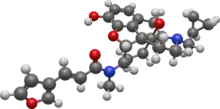 | |
 | |
| Clinical data | |
|---|---|
| Other names | TRK-820, AC-820, MT-9938 |
| AHFS/Drugs.com | International Drug Names |
| Routes of administration | Intravenous[1] |
| ATC code | |
| Legal status | |
| Legal status |
|
| Pharmacokinetic data | |
| Elimination half-life | 14 hours (acute);[2] 25–28 hours (chronic)[2] |
| Identifiers | |
| |
| CAS Number |
|
| PubChem CID | |
| IUPHAR/BPS | |
| ChemSpider | |
| UNII |
|
| ChEMBL | |
| PDB ligand | |
| CompTox Dashboard (EPA) | |
| Chemical and physical data | |
| Formula | C28H32N2O5 |
| Molar mass | 476.573 g·mol−1 |
| 3D model (JSmol) | |
| |
| |
| | |
Nalfurafine (INN, USAN)[3] (brand name Remitch; former developmental code names TRK-820, AC-820, MT-9938) is an antipruritic (anti-itch drug) that is marketed in Japan for the treatment of uremic pruritus in individuals with chronic kidney disease undergoing hemodialysis.[2][4] It activates the κ-opioid receptor (KOR)[5] and is potent, selective, and centrally active.[6] It was the first selective KOR agonist approved for clinical use.[7][8] It has also been dubiously referred to as the "first non-narcotic opioid drug" in history.[8]
History
Nalfurafine was derived from structural modification of the opioid antagonist naltrexone.[9][10] It was first synthesized and characterized in 1998,[2] and was approved for clinical use in Japan as an intravenous drug under the brand name Remitch in 2009.[4] The developer of nalfurafine also sought approval in Europe under the brand name Winfuran, but the Marketing Authorization Application was declined by the European Medicines Agency.[11] The drug was originally developed as an analgesic in surgery, but while effective in animal models of nociception,[12] it was repurposed as an antipruritic at lower treatment doses due to an apparently unacceptable incidence of sedative effects in humans.[4][7] As of 2015, nalfurafine is also in clinical trials for the treatment of cholestatic pruritus in Japan for patients with chronic liver disease, and for the treatment of uremic pruritus in the United States.[4][13]
Effects
Unlike other KOR agonists, nalfurafine does not produce hallucinogenic effects in humans.[6][7] Single intramuscular injections of up to 30 µg are well tolerated by humans, whereas a dose of 40 µg produced "moderate behavioral/psychological side effects" (possibly referring to sedation), though apparently did not produce any psychotomimetic or dysphoric effects.[14] In rodents, a low dose of nalfurafine (10–40 µg/kg) was found not to produce conditioned place preference or aversion, though a high dose (80 µg/kg) did induce significant place aversion.[6] The most common side effect of low-dose nalfurafine seen in clinical trials was insomnia (observed in 10–15% of patients), with few other adverse effects observed.[2][8] In addition, tolerance to the antipruritic effects of nalfurafine was not found after treatment of patients with the drug for one year, and nalfurafine has shown no evidence of either physical nor psychological dependence in humans.[8] The drug also shows lower evidence of tolerance for effects such as analgesia and sedation in animals relative to other KOR agonists.[6][15] In animals, nalfurafine produces anti-scratch, antinociceptive, sedative, and diuretic effects.[6]
Mechanism of action
Nalfurafine is an orally active, centrally acting, highly potent, selective full agonist of the κ-opioid receptor (KOR) (Ki = 75 pM; EC50 = 25 pM).[6] As touched on above, nalfurafine shows atypical properties as a KOR agonist relative to other drugs. Notably, it does not completely substitute for the prototypical KOR agonist U-50488 in rodents, indicating qualitative differences in the discriminative effects of the two compounds.[6] Moreover, unlike U-50488, it produces neither conditioned place aversion or preference in rodents.[16] The drug is a 4,5-epoxymorphinan derivative, and is structurally unique relative to other KOR agonists.[16] Nalfurafine may be a biased agonist of the KOR or a KOR subtype-selective agonist.[14] Indeed, it has been found to act as a biased agonist of the KOR, preferring activation of β-arrestin signaling in vitro, but paradoxically, β-arrestin appears to be responsible for KOR agonist-induced aversion,[17] and nalfurafine furthermore shows paradoxical effects in vivo that are not consistent with its in vitro profile.[18] As such, more research is needed to clarify the distinct mechanisms and effects of this drug.
Nalfurafine has been found in vitro to bind to the μ-opioid receptor and to possess weak partial agonist activity at this site, albeit with much lower affinity relative to the KOR.[19] However, in vivo, nalfurafine has shown no indications of MOR agonism or antagonism in animals or humans, including no evidence of rewarding or reinforcing effects or physical dependence.[19]
Research
Nalfurafine has been found to be effective in a variety of animal models relevant to drug abuse, addiction, and dependence, and may represent a novel potential treatment for these maladies.[6] In rodents, the drug attenuates the discriminative and rewarding effects of cocaine and the rewarding and locomotor effects of morphine, and diminishes the mecamylamine-precipitated aversive effect of nicotine withdrawal.[6]
See also
References
- ↑ Nunley JR, Lerma EV (3 July 2015). Dermatological Manifestations of Kidney Disease. Springer. pp. 85–. ISBN 978-1-4939-2395-3.
- 1 2 3 4 5 Inui S (2015). "Nalfurafine hydrochloride to treat pruritus: a review". Clinical, Cosmetic and Investigational Dermatology. 8: 249–255. doi:10.2147/CCID.S55942. PMC 4433050. PMID 26005355.
- ↑ Statement on a Nonproprietary Name adopted by the USAN Council
- 1 2 3 4 Cowan A, Yosipovitch G (10 April 2015). Pharmacology of Itch. Springer. pp. 304–305. ISBN 978-3-662-44605-8.
- ↑ El Daibani A, Paggi JM, Kim K, Laloudakis YD, Popov P, Bernhard SM, et al. (March 2023). "Molecular mechanism of biased signaling at the kappa opioid receptor". Nature Communications. 14 (1): 1338. Bibcode:2023NatCo..14.1338E. doi:10.1038/s41467-023-37041-7. PMC 10008561. PMID 36906681.
- 1 2 3 4 5 6 7 8 9 Rapaka RS, Sadée W (19 June 2008). Drug Addiction: From Basic Research to Therapy. Springer Science & Business Media. pp. 236–. ISBN 978-0-387-76678-2.
- 1 2 3 Patrick GL (10 January 2013). An Introduction to Medicinal Chemistry. OUP Oxford. pp. 657–. ISBN 978-0-19-969739-7.
- 1 2 3 4 Nagase H (21 January 2011). Chemistry of Opioids. Springer. pp. 34, 48, 57–60. ISBN 978-3-642-18107-8.
- ↑ Allerton C (2013). Pain Therapeutics: Current and Future Treatment Paradigms. Royal Society of Chemistry. pp. 73–. ISBN 978-1-84973-645-9.
- ↑ Nakao K, Mochizuki H (May 2009). "Nalfurafine hydrochloride: a new drug for the treatment of uremic pruritus in hemodialysis patients". Drugs of Today. 45 (5): 323–329. doi:10.1358/dot.2009.45.5.1377595. PMID 19584962.
- ↑ "Winfuran". European Medicines Agency - Human medicines. Archived from the original on 2016-08-19.
- ↑ Endoh T, Matsuura H, Tajima A, Izumimoto N, Tajima C, Suzuki T, et al. (1999). "Potent antinociceptive effects of TRK-820, a novel kappa-opioid receptor agonist". Life Sciences. 65 (16): 1685–1694. doi:10.1016/s0024-3205(99)00417-8. PMID 10573186.
- ↑ "Nalfurafine - Toray". AdisInsight. Springer Nature Switzerland AG.
- 1 2 Endoh T, Tajima A, Izumimoto N, Suzuki T, Saitoh A, Suzuki T, et al. (March 2001). "TRK-820, a selective kappa-opioid agonist, produces potent antinociception in cynomolgus monkeys". Japanese Journal of Pharmacology. 85 (3): 282–290. doi:10.1254/jjp.85.282. PMID 11325021.
- ↑ Suzuki T, Izumimoto N, Takezawa Y, Fujimura M, Togashi Y, Nagase H, et al. (January 2004). "Effect of repeated administration of TRK-820, a kappa-opioid receptor agonist, on tolerance to its antinociceptive and sedative actions". Brain Research. 995 (2): 167–175. doi:10.1016/j.brainres.2003.09.057. PMID 14672806. S2CID 25094224.
- 1 2 Nagase H, Hayakawa J, Kawamura K, Kawai K, Takezawa Y, Matsuura H, et al. (February 1998). "Discovery of a structurally novel opioid kappa-agonist derived from 4,5-epoxymorphinan". Chemical & Pharmaceutical Bulletin. 46 (2): 366–369. doi:10.1248/cpb.46.366. PMID 9501472.
- ↑ Ehrich JM, Messinger DI, Knakal CR, Kuhar JR, Schattauer SS, Bruchas MR, et al. (September 2015). "Kappa Opioid Receptor-Induced Aversion Requires p38 MAPK Activation in VTA Dopamine Neurons". The Journal of Neuroscience. 35 (37): 12917–12931. doi:10.1523/JNEUROSCI.2444-15.2015. PMC 4571610. PMID 26377476.
- ↑ DiMattio KM (2016). Studies on ligands of the kappa opioid receptor (Ph.D. thesis). Temple University. ProQuest 1710058225.
- 1 2 Nakao K, Hirakata M, Miyamoto Y, Kainoh M, Wakasa Y, Yanagita T (January 2016). "Nalfurafine hydrochloride, a selective κ opioid receptor agonist, has no reinforcing effect on intravenous self-administration in rhesus monkeys". Journal of Pharmacological Sciences. 130 (1): 8–14. doi:10.1016/j.jphs.2015.11.008. PMID 26786553.